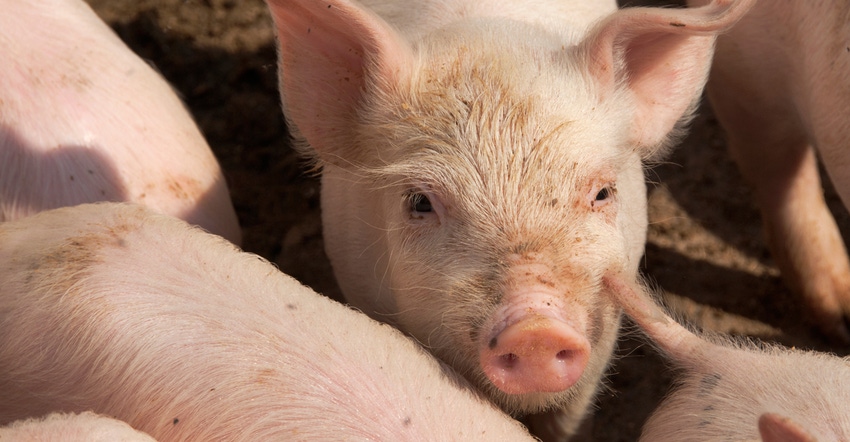May 4, 2022

Dhanansayan Shanmuganayagam likens some of the biomedical swine research being conducted at the University of Wisconsin-Madison to launching a space shuttle — he says it takes a team effort to get a complex research project off the ground.
Shanmuganayagam, an assistant professor in the UW-Madison Department of Animal and Dairy Sciences and co-director of the UW Center for Biomedical Swine Research and Innovation, is at the center of numerous projects that are using swine as homologous models to close the translational gap in human disease research. He is leading the effort to genetically engineer swine organs to make them as similar to human organs as possible, allowing researchers to conduct experiments on swine that can be translated to humans.
Swine models are being used to drive research in fields such as wound infections, heart disease, liver cirrhosis, metabolic disorders, imaging-guided radiotherapy systems, organ transplants, tumor ablation and ultrasound technologies.
Researchers have been using mice to conduct disease experiments for decades, but the size difference between mice and humans often makes the research difficult to translate. Primates have also been used in organ transplant research.
“With mice, the size and biology are so different,” Shanmuganayagam says. “Right now, in the U.S., it takes about 13 years and $2.6 billion to get a drug from conception into clinic, and then 93% of those drugs fail when they get to clinical trials. The reason the failure rate is so high is because we have been using animal models that are not very translatable early on, and when you get to clinical trials on humans, the drug doesn’t work.”

“It’s very satisfying,” he says. “It never goes fast enough, and it can be frustrating at times. Things often don’t work as you expect. But when things do work, that makes it all the more gratifying.”
For example, Shanmuganayagam has been involved in research on neurofibromatosis Type 1, or NF1, a disease where a chunk of a chromosome is missing in the human body. The missing chunk of chromosome is often a mutation in a single gene, called a neurofibromin 1 gene.
CRISPR technology
Using a gene-editing tool known as CRISPR, Shanmuganayagam and other researchers genetically alter the embryo of a pig and then impregnate a female pig with the embryo. The goal is to create a pig that represents a particular child, and then customize the treatment or therapy.
Ryan Geier, president of the Neurofibromatosis Network and the parent of a child with NF1, has been working with the UW research team since 2013. His daughter, Lauren, has dealt with an eye tumor, bone deformities, low muscle tone and a mild intellectual disability.
“People don’t realize how common neurofibromatosis is,” Geier says. “It is more common than cystic fibrosis and multiple sclerosis, for example. I had never heard of it until Lauren was diagnosed with it when she was 18 months old.
“The researchers have to use the CRISPR technology to genetically engineer the animal so the pig has the exact mutation as the human. This is no small undertaking, but Dhanu’s team has absolutely blown expectations out of the water. Pigs basically become avatars for the kids.”
Geier, who lives in Verona, Wis., has helped organize a golf outing that since 2013 has raised more than $450,000 for NF1 research.
“We’re doing what we can,” he says. “That’s peanuts in the research world. We need, like, 10 times that to make the needle move. But I want to continue to support [Shanmuganayagam] to make sure these guys have money to keep the momentum going.
“We need more research, but I truly believe that this model will open up treatments for patients with NF1 in the future.”
Shanmuganayagam says working with families like the Geiers is one of the things that keeps him motivated to continue research on NF1 and other diseases.
“We have built a community around this research — that has happened beyond what we expected,” he says. “We know a lot of the families, which is a satisfying part of it.”
Shanmuganayagam is co-director of the UW-Center for Biomedical Swine Research and Innovation with Dr. Dixon Kaufman, a transplant surgeon. Kaufman, director of the transplant program at the UW School of Medicine and Public Health, began working with Shanmuganayagam about two years ago when they could see the synergies involved in their research. Shanmuganayagam was refining his work on gene-edited pigs while Kaufman’s interest was in transplanting organs.

Kaufman notes that Shanmuganayagam also has an appointment as an assistant professor in the Department of Surgery, “which tells you how much the Department of Surgery values the partnership.”
“This partnership brings the whole College of Agricultural and Life Sciences much closer to the School of Medicine and Public Health,” Kaufman says. “There is really a lot of common ground that we can mutually support one another and develop some big things that neither group can do on its own.”
Kaufman and Shanmuganayagam both referred to a milestone transplant of a pig’s heart into a human on Jan. 7 of this year in Baltimore, Md., using a pig heart that had been genetically modified.
“It’s a milestone event that has captured the imagination of transplant clinicians and researchers who have been waiting to see the day when xenotransplantation comes to fruition,” Kaufman says of the January transplant. “This is as promising of an event as there has ever been.”
Kaufman estimates that he has performed about 1,000 kidney and 400 pancreas transplants during his surgical career.
“There’s an individual and family behind each of these transplants,” he says. “It’s not necessarily for the faint of heart.”
Unique partnership
Shanmuganayagam says the partnership between CALS and the UW School of Medicine is unique across the country.
“The UW is the only place that has the agriculture side as well as the medical side under one roof,” he says. “That makes it possible for us to do this research. The Biomedical Swine Research Center is one-of-a-kind, and we’re trying to take this to the next level.”
Using the university’s pig models, Shanmuganayagam and a medical team recently developed a new PET/MR imaging technique for diagnosing the severity of liver cirrhosis in patients. He has collaborated on the project with Dr. Ali Pirasteh, an assistant professor in the medical school’s Department of Radiology.
Pirasteh says he started working with Shanmuganayagam about 18 months ago when he became aware of the availability of swine models. He couldn’t ethically test the new PET/MR imaging technique on humans and found tests on mice to be unsatisfactory.
“Mice are very small, and they don’t mimic human disease as well as pigs,” he says. “Mice are cheap, so you can do a lot of studies and collect a lot of data. But the imaging is challenging. I would rather do a study on one good pig than 1,000 average mice. I can actually see everything at the right size that translates to the human body.”
Pirasteh is “hopeful and excited” that his research can eventually result in viable treatments for liver disease. The research team is planning to apply for approval from the federal Food and Drug Administration to move the study to the next level.
“Everybody thinks their research is cool and impactful,” he says. “But when I show the data to my friends and colleagues, they get excited, which is usually a good barometer. We have already generated liver fibrosis in the swine and demonstrated success. We are just dollars away, not time.”
Pirasteh says he and Shanmuganayagam are planning to submit their preliminary data to the National Institutes of Health and get additional funding to further validate their technique.
Shanmuganayagam, 48, has been at the UW since 1992, when he enrolled to pursue an undergraduate degree in bacteriology. He earned his doctorate in nutritional sciences from the UW in 2006, and completed his postdoctoral work in aging and caloric restriction in 2009.
His first appointment was at the UW School of Medicine and Public Health, before he was recruited to a position in the Department of Animal and Dairy Sciences. He has also worked at the Wisconsin Primate Research Center.
Massey lives in Barneveld, Wis.
You May Also Like




